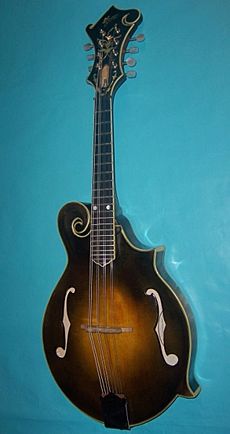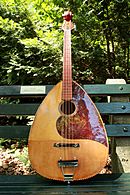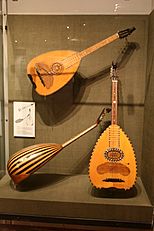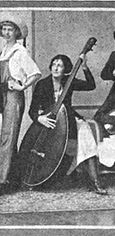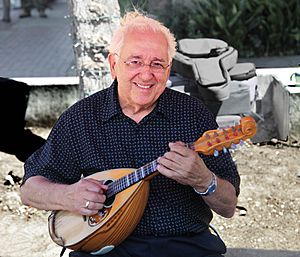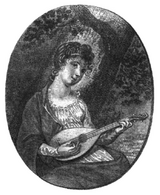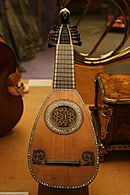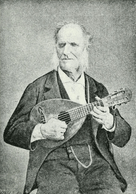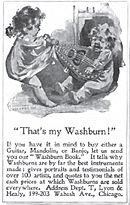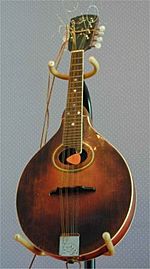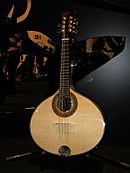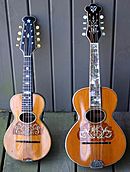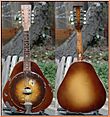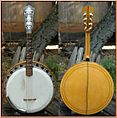Mandolin facts for kids
The mandolin is a cool musical instrument. It's like a small lute and sounds a bit like a violin or a hammered dulcimer. You play it by plucking its strings. Most mandolins have eight strings and are made of wood. They also have a fingerboard with frets, which help you make different notes. The first common mandolins came from Naples, Italy.
Contents
Meet the Mandolin Family
Just like there's a violin family (with violins, violas, and cellos), there's also a mandolin family! These instruments come in different sizes, each with its own unique sound.
Soprano Mandolins
These are the highest-pitched members of the family.
The Mandolin
The regular mandolin is the main instrument in the family. It's like the violin of the mandolin world.
- Its strings are tuned just like a violin: G–D–A–E.
- Most mandolins have a scale length (the vibrating part of the string) of about 330 mm (13 inches).
The Piccolo Mandolin
This is a very rare and tiny mandolin.
- It's tuned even higher than the regular mandolin, like a piccolo flute.
- Its scale length is usually around 240 mm (9.5 inches).
Alto Mandolins
These instruments play a bit lower than the soprano mandolins.
The Mandola
The mandola is tuned lower than the mandolin, like a viola is to a violin.
- It's tuned C–G–D–A, a fifth lower than the mandolin.
- Its scale length is usually about 420 mm (16.5 inches). In the UK, it's often called a tenor mandola.
Tenor Mandolins
These instruments have a deeper sound, similar to a tenor voice.
The Octave Mandolin
The octave mandolin is tuned a full octave (eight notes) below the regular mandolin.
- It's tuned G–D–A–E, just like the mandolin, but much lower.
- Its scale length is usually around 500 mm (20 inches).
- Sometimes, it's called an octave mandola in the UK.
The Bandol
This is a special type of mandolin found in Trinidad.
- It has a flat back and four sets of strings.
- The lower strings are made of metal and nylon.
The Irish Bouzouki
The Irish bouzouki looks and sounds a lot like an octave mandolin.
- It came from the Greek bouzouki, which is a long-necked lute.
- It's often tuned G–D–A–E, an octave below the mandolin.
- Irish bouzoukis usually have longer necks, from 560 mm to 610 mm (22 to 24 inches).
- People often use "octave mandolin" and "Irish bouzouki" to mean the same instrument.
The Cittern
The modern cittern is also related to the mandolin family.
- It has five sets of strings (ten strings in total).
- Its scale length is usually between 500 mm and 560 mm (20 and 22 inches).
- It's like an octave mandola with an extra set of strings.
- Other instruments like the 12-string Portuguese guitar and the 9-string waldzither are also distant relatives.
Baritone and Bass Mandolins
These are the deepest-sounding instruments in the mandolin family.
The Mandolone
The mandolone was a bass instrument from the Baroque period.
- It was part of the Neapolitan mandolin family.
- It was later replaced by the mandocello.
The Mandocello
The mandocello is tuned like a cello, an octave and a fifth below the mandolin.
- It's tuned C–G–D–A.
- Its scale length is usually about 635 mm (25 inches).
The Greek Laouto
The Greek laouto is a long-necked lute, similar to a mandocello.
- It has a bowl-shaped body and steel strings.
- Its scale length is usually about 710 mm (28 inches).
The Algerian Mandole
The Algerian mandole was created in the 1930s.
- It's a flat-backed instrument with a wide neck.
- It can have 4, 5, or 6 sets of strings (8, 10, or 12 strings).
- It's used in music in Algeria and Morocco.
- Players can tune it like a guitar, an oud, or a mandocello.
Contrabass Mandolins
These are the lowest-pitched instruments in the mandolin family, playing bass notes.
The Mando-bass
The mando-bass usually has four single strings.
- It's tuned like a double bass or an acoustic bass guitar: E–A–D–G.
- Gibson made these in the early 1900s, but they weren't very common.
- Most mandolin orchestras preferred to use a regular double bass.
The Tremolo-bass
This is a rare eight-string mando-bass.
- It has double strings, like most other mandolins.
- It's tuned two octaves lower than the mandolin.
Different Kinds of Mandolins
Mandolins come in several main styles, each with a unique look and sound.
Bowlback Mandolins
Bowlback mandolins are also called "roundbacks" because of their rounded, bowl-shaped backs.
- They are very popular around the world, especially in Europe and Japan.
- In the United States, people sometimes jokingly call them "potato bug" mandolins because of their shape.
Neapolitan and Roman Styles
The Neapolitan style is the most common bowlback.
- It has an almond-shaped body made from curved strips of wood.
- It usually has a slightly bent top, designed to handle the tension of its eight metal strings.
- Older instruments might have wooden tuning pegs, but newer ones use metal tuners.
- Famous Italian makers include Vinaccia, Embergher, and Calace.
The Roman style mandolin influenced the Neapolitan.
- It had a more curved and narrow fingerboard.
- It also had mechanical tuning gears earlier than the Neapolitan style.
Lombardic Styles
Another type of bowlback mandolin came from Milan and Lombardy in Italy.
- These mandolins are shorter and wider than the Neapolitan style.
- They have a shallow back and six strings (three wire and three gut or silk-wrapped).
- The strings are attached to a bridge glued to the top, like a guitar.
Brescian Mandolin
Some Brescian mandolins had four gut strings and were tuned in fifths, like the Neapolitan mandolin.
Cremonese Mandolin
In 1805, Bartolomeo Bortolazzi helped make the Cremonese mandolin popular.
- It had four single strings and a fixed bridge.
- Bortolazzi felt that the new wire-strung mandolins were harder to play than gut-string instruments. He also thought they had a "hard, zither-like tone" instead of a "softer, full-singing tone."
Makers Outside Italy
Many companies outside Italy also made bowlback mandolins.
- In the United States, Lyon and Healy (under the "Washburn" brand) and Martin were big makers.
- In Canada, Brian Dean makes mandolins in different styles.
- German makers like Seiffert developed their own style with a larger, rounder body.
- Japanese brands include Kunishima and Suzuki.
Archtop Mandolins
Near the end of the 1800s, a new style of mandolin appeared in the United States.
- These mandolins had carved tops and backs, like violins.
- This style was created by Orville Gibson, who started the "Gibson Mandolin-Guitar Manufacturing Co." in 1902.
- Gibson mandolins come in two main shapes:
- The F-style (Florentine): This has a fancy scroll near the neck and two points on the body.
- The A-style: This is pear-shaped and has no points.
- These mandolins usually have either f-shaped soundholes (like a violin) or an oval soundhole.
- In the US, F-style mandolins are very popular in bluegrass music.
- Original Gibson F-5 mandolins from the 1920s, designed by Lloyd Loar, are very valuable.
Flatback Mandolins
Flatback mandolins have a thin, flat wooden back, similar to a guitar.
- They usually have a round sound hole, but some have an elongated "D-hole."
- The body is often a rounded almond shape.
- This type was developed in Europe in the 1850s.
- The bandolim is a Portuguese flatback mandolin, popular in Brazil and the Philippines.
- In the 1970s, English luthier Stefan Sobell created a large, flat-backed mandolin with a carved top, often called a 'Celtic' mandolin.
Flatback Tone
Flatback mandolins are known for their warm and mellow sound. This makes them great for folk music and smaller performances. Their sound doesn't "punch through" other instruments as much as carved-top mandolins do.
Double Top, Double Back Mandolins
Some mandolins have a "double top" or "double back" design.
- This means they have an extra layer of wood inside, creating a second hollow space.
- This design helps to create a bigger and clearer sound.
- This idea has been around since the early 1900s, with instruments like the Sistema Ginislao Paris mandolins.
- Modern players like Avi Avital and Joseph Brent use these special mandolins. Brent's mandolin has a "false back" to make the wood sound clearer and less metallic.
Other Mandolin Types
Mandolinetto
The mandolinetto, or Howe-Orme mandolin, was shaped like a guitar.
- It had a unique bulge along the top.
- Another similar instrument was the Vega mando-lute, which had a bulge on its back.
Banjolin or Mandolin-banjo
The banjolin combines a mandolin with a banjo body.
- It was first patented in 1882.
- Today, a banjolin usually has four strings, while a mandolin-banjo has four sets of double strings.
Resonator Mandolin
A resonator mandolin uses metal cones inside to make its sound, instead of a wooden top.
- Famous brands include Dobro and National.
Electric Mandolin
Just like guitars, there are also electric mandolins.
- These have been around since the late 1920s or early 1930s.
- They can be solid-body (like an electric guitar) or acoustic-electric (can be played unplugged or plugged in).
- Some electric mandolins have extra strings or special parts to make the notes ring out longer, like an electric guitar.
Images for kids
-
In 1787 Luigi Bassi played the role of Don Giovanni in Mozart's opera, serenading a woman with a mandolin.
-
A mandolone played by Giuseppe Branzoli during a concert in Rome, 1889.
See also
 In Spanish: Mandolina para niños
In Spanish: Mandolina para niños


